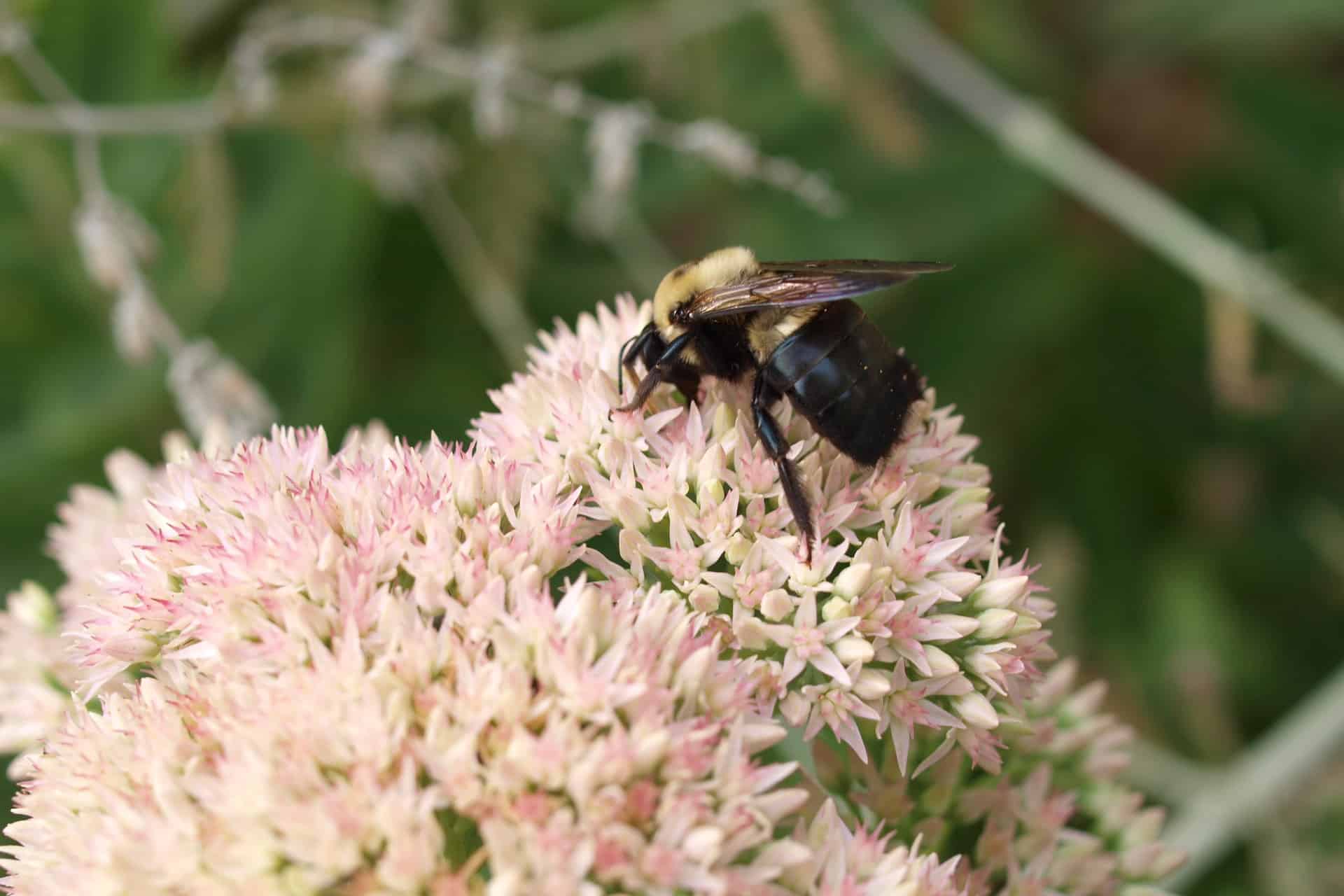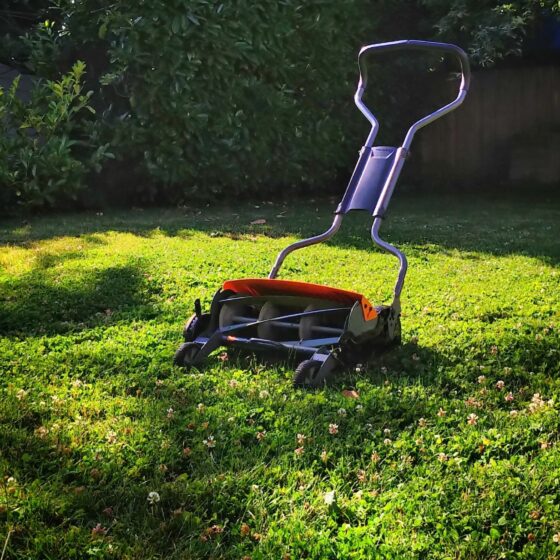Let’s face it, the sight of a carpenter bee hole on your eaves can be infuriating. However, killing its creator is a crime against your garden vegetables and flowers. So, what’s the solution?
If you’re wondering what to do in this situation, you’ve come to the right place! Here we’ll discuss how to get rid of carpenter bees in 13 different ways. We’ll expose the most effective humane methods of dealing with them but also mention some of the harsher ones.
So, scroll on, and find out how to have both — a happy, pollinated garden and damage-free property.
What’s a Carpenter Bee?
Carpenter bees are non-social bees that bear a great resemblance to bumblebees in size and shape.
But unlike the fuzzy, yellow-and-black-striped bumblebees, carpenter bees are almost entirely black (save for the fuzzy chest and back area, which ranges in color from yellow and brown to black).
A carpenter bee’s abdomen, which is the main distinguishing feature between the two insect species, is smooth, shiny, and entirely black. A male bee will also have white markings on its head.
Before you rush out to kill the carpenter bees in your yard, you should know that females rarely sting (only if provoked). And males can’t sting, even if they want to, as they don’t have a stinger.
What female bees are infamous for are the wooden tunnels that they “craft” when it’s nesting time.
Contrary to popular belief, carpenter bees don’t actually eat wood. They only chew through it with their sharp mandibles, creating long holes, earning themselves a spot in the category of pests.
Given the damage they can cause, nobody will blame you for wanting to get rid of carpenter bees on your porch as soon as possible.
How to Recognize Carpenter Bee Holes
Perfectly round and smooth, carpenter bee holes are, in fact, nests where the female carpenter bee lays eggs for the male to fertilize. This is also a nursery where larvae develop into adults and an over-the-winter shelter when the weather gets cold.
Measuring just a quarter of an inch in diameter, carpenter bee holes aren’t that big on the outside, but they can stretch for several feet inside the wooden surface.
“How do they do it?” you may wonder, knowing that they aren’t the largest of insects. The answer is simple — by returning each year and drilling a few inches deeper into the old nest’s structure.
This may sound awful, but there’s no reason for panic. There are ways to stop this before it even begins. Let’s see how!
How to Keep Carpenter Bees Away: Prevention Tactics
Besides the obvious (using another composite material for your deck shed and garden fence), there are many other easier ways to prevent carpenter bees from drilling your property.
Let’s check them out!
1. Finish Your Wood Surfaces.
The best way to prevent carpenter bee infestation and deter them from creating nests is to paint or stain your wooden surfaces. Pay special attention to eaves, fascia boards, decks, and window trims.
Add fresh finish to old and softened wood, especially cypress, cedar, or redwood. It’s also good to know that pressure treatment doesn’t deter carpenter bees from drilling holes in the wood.
2. Polish With Almond Oil.
If you want to get rid of carpenter bees on your deck without spraying it with toxic chemicals that can harm your pets, try this simple trick. Spray it with almond oil instead. This way, you won’t only deter the wood-drilling bees but also protect the wood from the elements.
3. Place a Decoy Hornet’s Nest.
Carpenter bees and wasps are afraid of hornets, so they’ll steer clear from nesting anywhere near a hornet’s nest. You don’t need the real deal to freak bees out and send them away from your house.
A simple paper bag filled with plastic bags could do, as long as it’s full and hanging from the ceiling.
And though it’s not a 100%-success method, trying to get rid of carpenter bees with a paper bag is easy enough to give it a go.
4. Seal Up Existing Holes and Cracks.
When searching for the perfect spot to nest, female bees look for imperfections, cracks, and openings to make their work easier. So, seal up holes and cracks before nesting season in spring to keep carpenter bees at bay.
You should also repair previous damage to the wooden surfaces created by carpenter bees.
Once you’ve sent your tiny tenants packing, get down to business immediately and fill up the nesting holes. You can use putty, wood putty, steel wool, caulk, and similar materials.
Failing to cover or seal bee burrows can trigger another visit from your buzzing friends.
5. Give the Bees a Nesting Suite.
Installing a so-called bee hotel in your yard will definitely attract carpenter bees. If the bees aren’t swarming the area, one should be enough for them to leave your property alone.
Skillfully designed bee hotels can make a beautiful decoration for your backyard, but that’s not all! Bee hotels will also make sure that carpenter bees stick around to pollinate your flowers.
How to Get Rid of Carpenter Bees Without Killing Them
Just like other bees, carpenter bees are pollinators. And much like them, they’re endangered, so killing them isn’t really doing anyone a favor. Luckily, there are few ways to deal with these buzzing carpenters without adding to the global bee crisis.
6. Make Citrus Spray.
The smell of citrus smell is repulsive to carpenter bees, so you can use lemon, lime, or oranges to make a homemade carpenter bee repellent.
Just put some citrus fruit in water (peels included) and boil it for 10–15 minutes until the juices are released, and voila! Once the solution cools down, you’ve got yourself a homemade remedy against infestation.
You can also extract the juice in your quality juicer first and mix it with water and boil it later.
7. Use Essential Oils.
Bees are sensitive to other smells besides those of citrus fruit. So much so that some scents will make them leave their nest.
To encourage this, spray some peppermint or tea tree essential oil near or inside carpenter bee holes and wait. Once the bees vacate the nest, you can seal it off for good.
8. Relocate the Infested Wood if Possible.
There’s a simple way to get rid of carpenter bees outside buildings — simply remove the infested wood and dispose of it in a convenient spot in your yard. Then, spray some essential oil on the wooden surfaces near the nest’s previous location.
9. Make Some Noise!
It might surprise you, but loud noise is a perfect way to make carpenter bees abandon their nests. Vibrations cause the bees enough stress to make them evacuate. Best of all, when disturbed in this way, they’re not likely to return to their nest.
How to Get Rid of Carpenter Bees for Good: Harsh Methods
Many still swear by the good-old extermination methods. But informed people know that they aren’t only cruel but non-effective.
If the conditions are right, bees will pay you a visit time and time again. And if you choose to spray insecticides around, you risk harming other types of bees and, thus, your flowering plants.
So, use the following methods only if you can’t get rid of carpenter bees naturally.
10. Place Bee Traps.
There are many trap designs available in garden stores. If this is the road you want to go, purchase a carpenter bee trap, which will help you spare the lives of other types of bees.
You can also opt for traps that you can empty and, in a way, give your “prisoners” a chance to survive after releasing them.
11. Use Homemade Insecticides.
If you’re allergic to bee stings and you don’t want to take your chances, you can get rid of carpenter bees with vinegar and boric acid — the most effective bee killers, which you probably have at home.
Just spray these in and around bee holes, and you’ll kill their occupants.
However, keep in mind that this isn’t as fast-acting as commercially-bought insecticides and pesticides. If you decide to use these instead, use protective gear as well for your own safety.
12. WD40
If you don’t have an insecticide on hand, you can get rid of carpenter bees with WD40. Spray some on infested surfaces or directly on these wood invaders and wait for a few secs until they perish.
13. Hire Professionals.
If the magnitude of the infestation you’re dealing with is too big for you to handle, ask professionals to help you out. Bee exterminators use insecticides and other toxic chemicals that get rid of bees for good, so use this only as a last resort.
Bottom Line
Getting rid of carpenter bees is always a double challenge for the environmentally aware. Not only should you protect your wooden property from this pest, but you should also try to avoid cruelty while doing it.
We hope these tips gave you the right solution for your situation and peace of mind.
And remember, if things aren’t going as you hoped, you can always hire professionals to help you deal with these stubborn insects.
Good luck!
FAQ
What attracts carpenter bees to my house?
If you have a carpenter bee infestation, your house most likely features wooden siding, an old fence, a deck, or other unfinished wooden surfaces. Pine and cedar are especially appealing to these havoc-wreaking insects.
Carpenter bees also re-visit old nests, so don’t be surprised to see them around if you live near one. And the presence of flowers doesn’t help either, as pollen is their main food source.
Will vinegar kill carpenter bees?
Though vinegar isn’t as fast-acting as commercially available insecticides and pesticides, it’s just as deadly — and not only for carpenter bees! It also affects honey bees, bumblebees, and even your plants.
Vinegar chemically burns carpenter bees and is a cruel way of dealing with these important pollinators.
Should you kill carpenter bees?
Definitely not! Carpenter bees may be a nuisance for you, but they’re indispensable for the ecosystem your garden is part of. You should deter or relocate carpenter bees rather than kill them because they enable the reproduction of flowers and crops.
What home remedy keeps carpenter bees away?
The scent of tea tree, peppermint, lavender, and above all, citrus is repulsive to carpenter bees. So, put these essential oils and fruits to use. Make a fruit peel tea, wait for the solution to cool down, and spray it on areas with a high risk of carpenter bee infestation.
How do you keep carpenter bees from coming back?
Sealing cracks and openings is an excellent way to keep carpenter bees away from your doors, beams, and other wooden surfaces. The very best method, however, is to stain or paint the wooden surfaces.
Alternatively, you can also polish the wood with almond oil or use a decoy bee hotel in the garden. And think twice before completely eliminating them since they’re useful pollinators.
Now you know how to get rid of carpenter bees and prevent them from coming back. So, what are you waiting for?! Pick one of the methods and become carpenter bee-free!













